Have You Ever Heard of a “Two Year Visit”?
Top photo: koshinuke_mcfly on Pixabay
Timothy shares his tale of how 2021 began with a visit to a shrine…
Have you already made your wishes for 2021? If you haven’t, then perhaps you might like to know about how I got my fortune this year before you discover yours!
An Introduction
A week before New Year’s Eve, I told my friend I could not go home for Christmas or New Year’s Day due to the Coronavirus pandemic, which still has the world in its grip.
I had already brainstormed several ideas on how I would spend my New Year’s celebration in Japan alone. In fact, I was searching for the highest mountain or viewpoint in my local area to watch the first sunrise of 2021. But as we all know, things change.
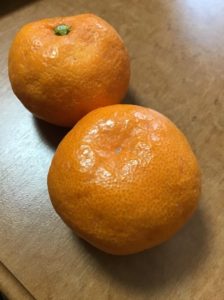
Japanese mikan – orange-like fruit which can be a nice, simple gift.
Three days before New Year’s Eve, my friend calls me.
“Tim! I just spoke to my mother, and she said it was okay for you to come celebrate New Year’s Day with us! I’m so excited because I can introduce my family to you!”
This was indeed a special occasion – my first New Year in Japan, and I wouldn’t be alone.
On New Year’s Eve, we arrived at his family home, did our greetings, and tucked ourselves under the warm kotatsu that was already prepared. I made sure to bring some snacks and the seasonal fruit – mikan as an appreciation for the hospitality. Like most cultures, whenever you are visiting someone’s home, you should almost never go empty-handed.
The Two Year Visit
In Nagano prefecture, there is a cultural tradition called the ni-nen mairi (二年参り) – a “two year visit”, where essentially you go to the shrine ‘between’ the year that just passed, and the year that’s about to arrive. So, at 11:45pm, we made our way to the local shrine to do just that. When we arrived, there were about 15 other people who were waiting in line to make their prayers to the local god or spirits. A campfire had also been set up to keep everyone warm in the minus 3°C temperature.
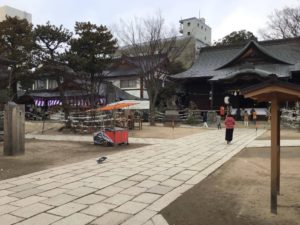
Yohashira Jinja (shrine) in Matsumoto-shi, Nagano-ken.
Once it’s your turn to pray, there are a few things you need to do. The first step is to give an offering inside a box placed in front, usually a five- or fifty-yen coin (because they are the only coins with holes, and are considered lucky). Second – aisatsu (あいさつ) – greeting by bowing twice. Third, clap two times and pray (in the case of New Year, saying thank you for the previous year and for continued support in the New Year is important).
Lastly, another aisatsu (あいさつ) before you leave. Now during the prayer, many people tend to make a wish during this time. In this period, I would assume most are wishing for an end to the coronavirus pandemic soon.
Now for the New Year Fortune
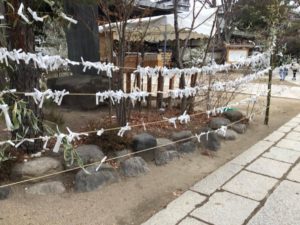
Fortunes with no luck tied to trees at Yohashira Jinja.
The most exciting part of the shrine visit is getting to pick out your fortune. After making another offering (which may vary from shrine to shrine), you pick your fortune out of a box like a lottery. Each fortune is numbered and is printed on a rolled-up strip of paper. There are two parts to your fortune.
First is a general message about your luck called kami no kyou (神の教) – “god’s teaching”. The second part is advice for many aspects of your life, from education, relationships, health, business, to even your personal battles. It is important to note that these fortunes contain old Japanese which even locals struggle to understand. So, it’s worth having someone there who can translate your fortunes for you.
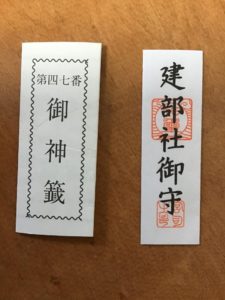
Rolled up printed fortune (left) and Amulet (right)
Another thing to keep in mind is there are three levels of luck when you pick out your fortune. Very simply, you either get ‘good luck – ‘normal luck’ – or ‘bad luck’.
In the event you get ‘bad luck’, the general practice is to tie your fortune strip to a tree or designated string in hopes that it will ward of bad spirits and reduce the chance of ‘bad things’ happening.
During your shrine visit you may also choose to purchase an amulet. As long as you have this on your person, it will keep you safe and protect you from bad spirits, according to common belief.
Conclusion
If you haven’t made your first shrine visit of the year, I bet you are now itching to experience a part of this interesting cultural tradition and find out what your fortunes for 2021 are! I hope you have a better understanding of shrine visits in Japan and the common process. Have a great year, and I wish you good fortune!
Want to make your own experiences in Japan? Now you can as an Assistant Language Teacher! For more information, read all about the job of an ALT!
Photo Credits:
Top photo: koshinuke_mcfly on Pixabay
Additional photos for this article were provided by Timothy Leong, used with permission
All other content (text) created by the original author and © 2021 MUSUBI by Borderlink
Top Photo: chezbeate on Pixabay
Tea. Wars have been fought over it. Revolutions have been waged because of it. And people around the world just can’t get enough of it.
It is said that globally, 25,000 cups of tea are consumed every second- about 2.16 billion cups per day. While tea comes in many flavors and colors, one variety that attracts a lot of attention- and is the focus of a great deal of controversy in the world of healthy living- is green tea.
“Tea is the most wonderful medicine for nourishing one’s health; it is the secret of long life.” So wrote the Zen Buddhist priest Eisai (1141-1215) in his preface to the Kissa Yōjōki (喫茶養生記, “Drink Tea and Prolong Life”), the first Japanese treatise on tea. In 1191 Eisai had brought brought back tea seeds from China, which he then planted on the island of Hirado and in the mountains of Kyushu. As well as popularizing the drinking of tea in Japan, he advocated that all people, not just Buddhist monks and the elite, drink tea for its health benefits. But are those benefits real or just fantasy?
Even today, health experts continue to debate about the true effectiveness of green tea. Its use as a health supplement is often associated with a slight improvement in the overall quality of one’s life, but does it actually do anything? Studies about its effectiveness on everything from preventing cancer to aiding weight loss have proven inconclusive at best.
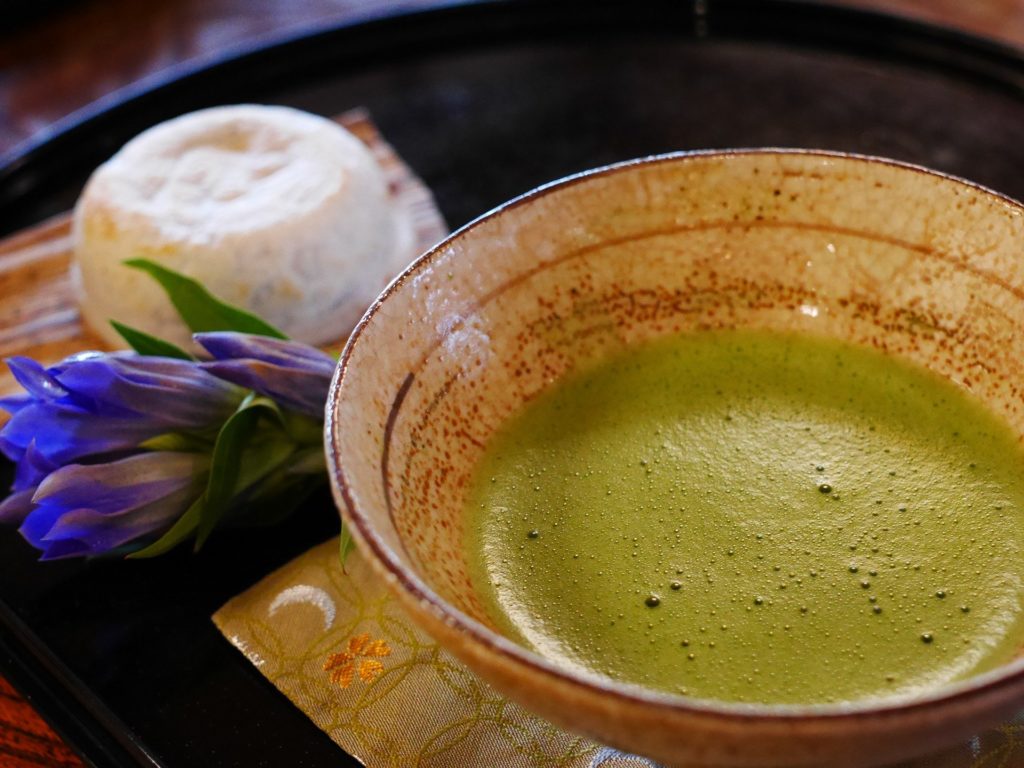
The closest thing to a consensus reached so far is that it is beneficial to the brain and heart; Green tea has been shown to improve blood flow and lower cholesterol. One study revealed that people who drank green tea had greater activity in the working-memory area of their brains, and it can be effective in mitigating the effects of Alzheimer’s disease. While it may not be a miracle cure-all, it continues to enjoy popularity as a healthy staple in one’s diet and an excellent alternative for coffee or sugary soft drinks (due to the caffeine content, of course.)
In Japan, all commercially-produced teas are of the green variety, although there are many sub-variations under the nebulous label of Japanese Tea (日本茶). These include the thick, heavy Matcha (抹茶), well-known for its use in traditional tea ceremonies; Hōjicha (ほうじ茶), which is notably roasted rather than steamed like other Japanese teas; and Sencha (煎茶), the most popular variety and probably the one you’ve had if you ever bought a bottle of cold green tea on a hot summer day from a vending machine.
The debate about whether green tea is a magical elixir or not will continue to rage. In the end, maybe it’s just a healthier alternative when compared to other beverages you could be imbibing. Whatever the case may be, it’s a tasty and refreshing drink year-round. Whether you enjoy it hot or cold or heavy or light, green tea is a quintessential taste of Japan. And, perhaps, the secret to a long life after all.
Photo Credits:
Top Photo: chezbeate on Pixabay
Additional photo: naturalogy on Pixabay
All other content (text) created by the original author and © 2021 MUSUBI by Borderlink
Top photo: provided by MUSUBI staff member, used with permission
Bonomine is one of the hidden gems Japan is famous for. If you need to refresh your mind, body, and soul with some clean mountain air, look no further than this mountain and its enchanting gorge. Bonomine (棒ノ嶺) has the delicate beauty and aesthetic that we all imagine in our minds when we think of Japan. Head out early, strap on some hiking shoes, and pack a lunch, because this is an all-day event.
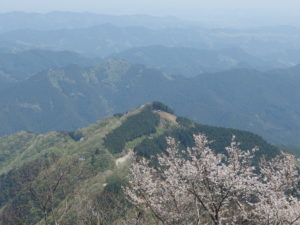 Bonomine is the name of a mountaintop just a little west of Hanno, Saitama. The mountain itself is nice and has a great view, but the main appeal of this trip is the gorge trail leading up to the summit. A trickling stream creates pools that collect flower petals in the spring and maple leave in the fall. The landscape has the ability to instantly transcend you into a Zen-like state-of-mind. With each bend of the gorge a new awe-inspiring scene presents itself before your eyes.
Bonomine is the name of a mountaintop just a little west of Hanno, Saitama. The mountain itself is nice and has a great view, but the main appeal of this trip is the gorge trail leading up to the summit. A trickling stream creates pools that collect flower petals in the spring and maple leave in the fall. The landscape has the ability to instantly transcend you into a Zen-like state-of-mind. With each bend of the gorge a new awe-inspiring scene presents itself before your eyes.
The gorge goes straight up to the ridge and is a steep one. In some places ropes and chains are set in place to aid hikers upward. Despite this, the route is completely safe and doesn’t require any special set of skills. A beginner can do this hike. For someone who hasn’t gone on a hike in a long time, they will feel tired and want to rest, especially if going for the peak. Try not to take too many long breaks, especially if you plan to climb to the peak.
The beautiful gorge abruptly ends and a dirt road that comes out of nowhere after about an hour of hiking with no stops. This is a good place to decide if you want to continue on to the summit of Bonomine or take the ridge trail back to the bus stop. The ridge to the summit takes another hour. Going down from the road, back to the onsen and bus stop, takes about 90 minutes.
If you take the summit option, you are awarded with a great view of the Chichibu mountains and the Kanto Plain. The summit has a big grassy area and plenty of places to enjoy a well-deserved picnic.
From the summit back to the road takes about two hours and is on a beaten-down path along a ridge. At the end of the trail is Sawarabinoyu Onsen, where you can enjoy a nice hot bath if you wish. Otherwise, you can head to the parking lot and wait for the next city bus to pick you up and whisk you back to civilization.
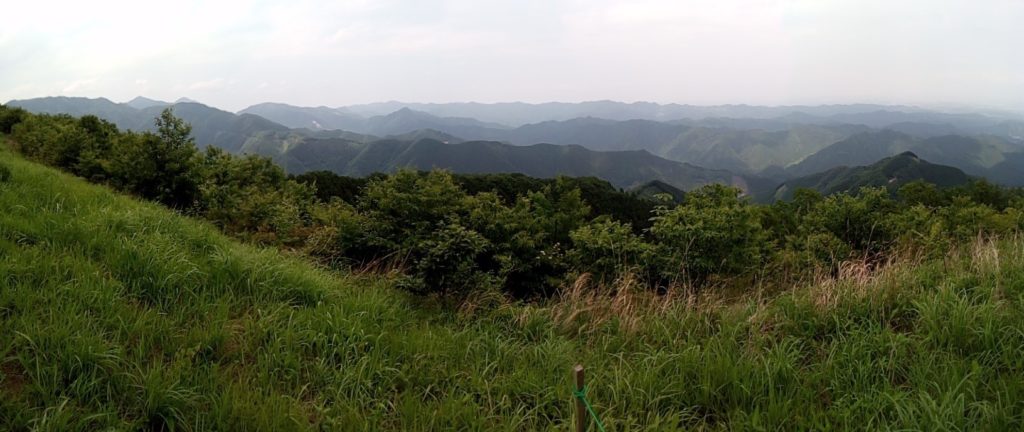
The gorge, summit, onsen, and even the bus ride through the countryside to the trailhead all combine to create a near-perfect activity for just about anyone. And best of all, if you live in Tokyo, it’s all less than a day away!
Access: To get to the trailhead it is necessary to take a train to Hanno Station (about 1 hour from Shinjuku), take the North Exit No.2 Bus Stop. Then take a local bus 1 (to Yunosawa) or 2 (to Naguri Shako) ride it for about 40 minutes. Get off at Kawamata Naguriko Iriguchi. From the bus stop, look for signs to Sawarabinoyu Onsen, then head up to the dam. The entrance to the gorge trail is on the left when facing the dam.
Ready to find your own hidden treasures around Japan? Now you can as an Assistant Language Teacher! For more information, read all about the job of an ALT!
Photo Credits:
Top photo: provided by MUSUBI staff member, used with permission
Additional photos provided by Adam Mathews, used with permission
All other content (text) created by the original author and © 2021 MUSUBI by Borderlink
Top photo: Jezael Melgoza on Unsplash
There are various social faux pas in Japan that everyone, particularly those new to the country, should be aware of before coming on over. Because Japan is a very polite and
community-focused society, there is a level of behavioral expectation from each individual that is perhaps not apparent to everyone coming here for the first time. It is important to learn and be aware of your behavior and actions in Japan so that you do not cause any trouble or offend others. Japanese people will also appreciate and develop a mutual respect for your efforts!
Train Voices
 The first and most common social faux pas is speaking too loudly on the trains. Unlike in China, America or the U.K., trains in Japan are usually quiet. People are very mindful about not bothering others, so this is particularly important.
The first and most common social faux pas is speaking too loudly on the trains. Unlike in China, America or the U.K., trains in Japan are usually quiet. People are very mindful about not bothering others, so this is particularly important.
Personally, I have seen my fellow foreigners commit this faux pas countless times, so it definitely deserves to be mentioned. In addition, people here will generally not tell strangers to stop or quiet down outside of extreme cases, so you have to be aware of it yourself. It goes without saying that talking on the phones in a train is usually not recommended.
Eat-Walking (or is that Walk-Eating?)

The second social faux pas has to do with eating. Generally speaking, if you purchase a snack or drink from a convenience store, it is fine to eat it right outside of the store away from the middle of the sidewalk. It is, however, usually not a good idea to eat while walking, which has traditionally been considered rude. A major reason why the streets in Japan are so clean is precisely because the rules are in place to prevent litter from being thrown everywhere in public areas.
There are exceptions to this though. It may be common to see people walking and eating in theme parks or during festivals when snacks and ‘finger foods’ are in plentiful supply at stands and carts. In general, this is one faux pas that’s faded somewhat with the younger generation. People will still usually try not to make a mess or inconvenience others with their eating though. The safest solution is always to slow down and find a place to enjoy whatever it is you’re eating, rather than risk dropping it all over yourself and the street.
Shoes Off
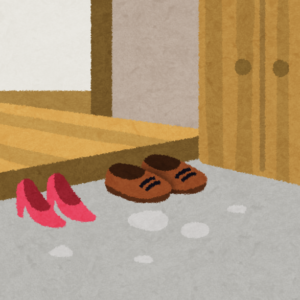 The last social faux pas is a widely-known one, but still deserves to be mentioned
The last social faux pas is a widely-known one, but still deserves to be mentioned
because it’s arguable the most important. Wearing outdoor shoes indoors is quite common in America, but it is definitely not the case in Japan.
At the genkan, or entrance, of a house or shop, please take off your outdoor shoes and use the indoor slippers instead. This helps keep the owner’s house or establishment clean. It would be very disrespectful otherwise.
Although sometimes social etiquette in Japan may seem strict overall, the benefits that
come with following the rules are apparent in everyday life. Try not to stress yourself over the minute details, but also be aware and respectful of the local culture. It will definitely improve your relationship with the Japanese people, because respect is a two-way street; it is mutually-shared and given.
Photo Credits:
Top photo: Jezael Melgoza on Unsplash
Additional images provided by Irasutoya
All other content (text) created by the original author and © 2021 MUSUBI by Borderlink
Are you looking for a city that offers all the modern comforts, but also rustic charms? Do you want plenty of green to go along with that urban grey? Are you seeking out a place in Japan that encapsulates the “old meets new” philosophy even better than Tokyo? Then maybe it’s time to give one of the lesser-known prefectures a try and come on over to Okayama!
If you’re familiar with the popular hero of Japanese folklore, Momotarō (桃太郎, “Peach Boy”), Okayama is his hometown! West of Kansai but not quite as far as Hiroshima, Okayama is known as the “Land of Sunshine”, purportedly because it has more sunny days and fewer rainy days than other prefectures in Japan. This makes it a very livable area, but also quite a nice one for travelers just like me!
Here are my top 5 sights on interest in Okayama:
Okayama Kōrakuen Garden (岡山後楽園)
Okayama Korakuen Garden is a picture-perfect landscape garden, and often viewed as the main attraction in all of Okayama.
Okayama Korakuen is one of the Three Great Gardens of Japan, the best-of-the-best known nationwide among horticulturists, flower aficionados and admirers of all things beautiful. It is located just beside Okayama Castle, which can be seen from the garden. One can truly feel an aesthetic sense of old Japanese culture in this part of Okayama City.
You can also enjoy the cherry blossoms during spring, and kōyō season in particular is spectacular in the garden. They also hold a light-up event every spring (Golden Week), summer, and autumn called Genso Teien (Fantasy Garden). During the event, you can enjoy the Japanese street food stalls called Yatai (you might remember the last time I wrote about some of those!)
Kurashiki Bikan Historical Area (倉敷美観地区)
Kurashiki Bican Historic Area is like a miniature Kyoto in Okayama. The place is surrounded by traditional Japanese houses, white stone walls, traditional buildings, and a historically attractive atmosphere.
One of the popular activities here in Kurashiki’s historic area is the traditional boat tour of Kurashiki Canal, and experiencing wearing Yukata or Kimono while strolling through Kurashiki’s historic streets.
The Bikan Historical Quarter also offers washoku (Japanese cuisine) restaurants and local confection shops where visitors can enjoy a real taste of traditional Japanese food. And in the evening, this area is… well, a picture is worth a thousand words.
Kibitsu Shrine (吉備津神社)
Kibitsu Shrine is the gem of the Kibi Plain in Okayama Prefecture. It’s an area surrounded by gardens and trees, full of history, culture, and mythology.
Kibitsu Shrine is closely inspired by the famous Japanese folk tale “Momotarō.” It was rebuilt in 1425, and the building at the heart of the shrine is considered a National Treasure.
During the rainy season (early to mid-July), you can see the beautiful Ajisai (Hydrangea) along with the shrine. For a souvenir, you can buy famous peach-shaped ‘romance amulets’ known as “Momomamori.”
Kirin Beer Factory (岡山キリンビール工場)
Are you a beer lover? If yes, you should definitely try to experience a tour at the Kirin beer factory! Kirin has a long history that is closely tied to the history of beer in Japan, and Okayama’s beer factory is one of Japan’s leading beer producers.
You can participate in the tour for free (but make sure you make a reservation!) to see the detailed brewing process, product packaging, and commentary provided by a Japanese tour guide. After the tour, participants can taste at least three cups of fresh beer or other Kirin drink products.
Kasaoka Bay Farm Flower Garden (笠岡ベイファーム)
Want to relax with the stunning view of flowers? This place is perfect for you!
Kasaoka Bay Farm is known as one of western Japan’s best flower gardens, and you can enjoy seasonal flowers nearly all year round. You can get there by bus from JR Kasaoka station.
You can see about 10 million canola flowers in March and April, 10 million poppies in May, one million sunflowers from June to August, and 30 million cosmos flowers in October.
Those are my five picks, but I encourage you to come out here and find your own as well! There’s a lot of activities, food, and souvenirs that can’t be found or experienced anywhere else! I’m sure you’ll find lots of gifts you’d want to take home and lots of memories you’ll want to brag about!
Thank you for reading taking time to read, and I hope you enjoy your stay in Okayama in the future!
Okayama is beautiful place. But why just settle for living in a small town when you could live and work right in Okayama City, with easy access to all of the above? Now you can as an Assistant Language Teacher! For more information, read all about the job of an ALT!
Photo Credits:
Some information and photos cited in an earlier version of this article came from Okayama Kanko Net.
All other content (text) created by the original author and © 2021 MUSUBI by Borderlink
Top photo: wang xi on Unsplash
Sure, when you live overseas you expect some things will be different from the life you had in your home country. That’s part of the excitement. For Japan, I expected that to be conveyor-belt sushi dinners and occasionally seeing people wear kimono (both of which certainly happen from time to time). But what I didn’t anticipate were the subtle ways I began to imbibe Japanese culture.
After one month of living in Japan, of course your chopstick skills will go through the roof. You expect that. Your Japanese language proficiency increases without much effort (although formal study is highly recommended to make significant gains). You go from timidly saying konnichiwa and arigatou to understanding the convenience store clerk when they ask if you want your meal heated up. You can guess those changes will happen before you get here. What you don’t expect, however, is to be someday yelling at the TV screen when your favorite sumo rikishi (wrestler) is robbed or eating natto (fermented soybeans) for breakfast every morning and actually liking it. How did this happen?
One case in point concerns the act of bowing. Bowing is one aspect of Japanese etiquette that is well known worldwide and expected upon arrival. What is amazing about this peculiar cultural phenomenon, though, is how it gradually seeps into your subconscious and becomes second nature. Everyone knows to bow when you meet someone for the first time.
Even fresh-off-the-plane foreign visitors know this. You study these things in a guidebook or on YouTube before you arrive. You even laugh – politely and to yourself – the first time you catch a glimpse of a Japanese person giving a slight head bow while talking on the phone. What did I just see? Why would they do that? The other person can’t see you. And then, it happens. Enough time passed, and one day, I eventually caught myself doing the very thing I once inwardly mocked. I was head bowing while talking to my boss… while on the phone. I think I’m turning Japanese, I really think so.
I had read a lot about “culture shock” before I came to Japan the first time. Almost any literature on this topic will at some point cover the Japanese practice of removing one’s shoes before entering a house. Ok, that sounds fair. Sounds pretty clean actually. The more I thought about it, I kind of realized, “hmm, my own culture is a little bit gross for walking around in our homes wearing the same shoes we had on outside.” The supposed “shock” of having to frequently remove my shoes didn’t come as much of a surprise or burden at all.
Then, without reading about it, I discovered “reverse culture shock.” I took a trip back to my home country of America and was appalled to see my family members sauntering around the house. Wearing shoes! On the carpet! I was mortified. Had I turned Japanese? I think I might have a little.
Still, there was one aspect of Japanese life that I was certain would never take hold in my thoughts or actions: slurping. In Japan, one should noisily slurp one’s ramen noodles to (a) cool the piping hot broth and (b) as an indication of satisfaction to the chef. Not me, I thought. I’ll never publicly slurp my noodles. It goes against childhood lessons learned at the dinner table.
I will be understanding of others, of course. It is their culture and I am in it. When in Rome, do as the Romans, as they say; so when in Japan… ok, I’ll tolerate ramen noodle slurping. I would observe, but not participate. I mean, how could this seemingly eccentric behavior ever become part of my delicate, refined dining repertoire?
It starts at home when no one else is around. It starts with that cup of instant ramen you get at the convenience store. You practice when you are sure no one can hear. Eventually, seemingly out of nowhere, all of your inner impulses to resist suddenly fade away and you slurp with reckless abandon! The transformation was complete. I had become Japanese.
So, I might have turned (a little bit) Japanese from my time here. Is that such a bad thing? Not at all. I am grateful for my experiences and transformations. Aside from the specific cultural adaptations, the transformation itself – i.e., just the gradual act of personally evolving – has made me a more mindful person and provided many opportunities to laugh at myself. For that (and for the sumo and natto), I will always be grateful to Japan.
Photo Credits:
Top photo: wang xi on Unsplash
Previous photos provided by Mark Reid courtesy of Smithsonian.
All other content (text) created by the original author and © 2021 MUSUBI by Borderlink
Top Image: Type specimen licensed under the Creative Commons Attribution-Share Alike 3.0 Unported license. Wikimedia Commons Link
Osaka aka “The Nation’s Kitchen” is indeed the best place to be if you’re a foodie like me. You will find the most mouth-watering and delectable dishes here, the kind of foods that will have you shrugging at those extra pounds you will absolutely put on.
But what some many not realize is that in Osaka- the land of takoyaki, yakisoba and just about every other food that can be yaki‘d out there- you can still find many different types of foods from all over. That “all over” includes in Japan and beyond! Here are 3 of my favorite places to grab a bite in Japan’s Second City, all of which offer a taste of something different.
DISCLAIMER: Grab a snack before continuing on!
Soul Food
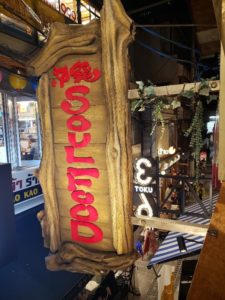 Soul Food is a restaurant dedicated to Okinawan food. And let me tell you… this place is amazing!!
Soul Food is a restaurant dedicated to Okinawan food. And let me tell you… this place is amazing!!
Location: Umeda
Food: 10/10
The folks here are the best. They are very honest and kind (and cute!) and you will receive great customer service. The prices are a bit steep, but it is absolutely worth it. Being an Okinawan restaurant, they specialize in Goya, which I personally have a hard time stomaching, but there are many other dishes on the menu that are definitely worth a try.
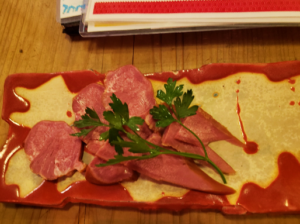
The Pork Tongue (right) is so soft it practically melts in your mouth. Okinawan-style Seaweed is an interesting food to try- the tiny green bulbs pop in your mouth. It’s quite fun to eat!
But let’s get right down to this big, nasty one: Goya.
I only say it’s nasty because I don’t like it, but my friends seemed to enjoy it! They find ways to mix Goya into everything here! We asked the waiter “Is the Goya cocktail any good?” and his face was priceless! The man tried to be honest and told us it’s bad, but I think my friend had a death wish and ordered it anyway!
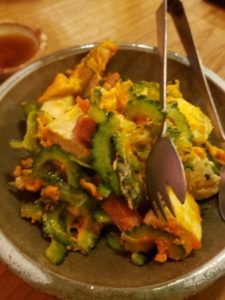
For those who love it though, I do recommend the Goya Champuru. It’s Goya mixed with tofu and meat. The Goya completely overpowers everything else in this dish. But if you like Goya, give it a try!
Unfortunately I don’t remember the name of my favorite dish, but it contains the interesting mix of ham and dragon fruit!
I never would have thought these entirely different things would taste so good together, but it is to die for. We ordered this twice!
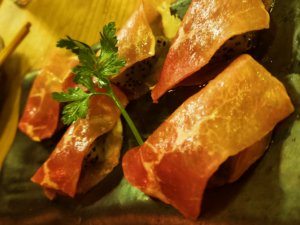 The ham is thinly sliced, savory and soft, and wrapped around the chilled dragon fruit. Somehow the dragon fruit cleanses your palate while eating the ham, and it’s just indescribable. If you’re in Umeda this is a must try. I promise you’ll order two (or more) servings as well!
The ham is thinly sliced, savory and soft, and wrapped around the chilled dragon fruit. Somehow the dragon fruit cleanses your palate while eating the ham, and it’s just indescribable. If you’re in Umeda this is a must try. I promise you’ll order two (or more) servings as well!
PUSAN
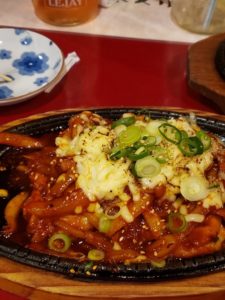 Pusan as you might guess from the name is a Korean restaurant. Many people go here after work. It is very tiny inside but this creates a wonderful, happy atmosphere.
Pusan as you might guess from the name is a Korean restaurant. Many people go here after work. It is very tiny inside but this creates a wonderful, happy atmosphere.
Location: Umeda
Food: 10/10
I came here twice. I love spicy food and I ate cheese buldak once before, so guess what I ordered?
If you guessed cheese buldak then you’re right! Buldak is boneless chicken, here covered in melted cheese, spice and everything nice!
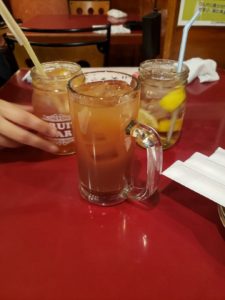 This was so spicy it made my ears burn. My face was on fire but it was sooooo good! Personally, the portion was a bit small, but it’s a good meal to share if your spice tolerance isn’t high. Please specify if you want buldak or cheese buldak! The cheese makes all the difference in my opinion.
This was so spicy it made my ears burn. My face was on fire but it was sooooo good! Personally, the portion was a bit small, but it’s a good meal to share if your spice tolerance isn’t high. Please specify if you want buldak or cheese buldak! The cheese makes all the difference in my opinion.
The workers only speak Korean and Japanese and there is no English menu, so prepare to use your trusty translator if you only speak English. Despite the language barrier, Pusan is another must-visit.
Nigiri Chojiro
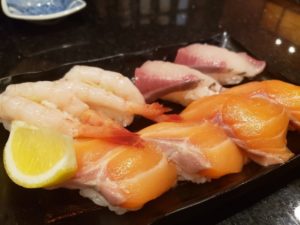 Nigiri Chojiro is a Sushi restaurant. This sushi shop has conveyor belt-style sushi, but you can also dine-in at a table and make your own orders. They also have somen, soups and some delectable desserts (mostly mango)
Nigiri Chojiro is a Sushi restaurant. This sushi shop has conveyor belt-style sushi, but you can also dine-in at a table and make your own orders. They also have somen, soups and some delectable desserts (mostly mango)
Location: Ibaraki
Food: 8/10
I was never a person to crave sushi, but after coming here several times I now have made a point of stopping by almost every week. Upon entering you can choose to sit at the conveyor belt or at a table. Sadly, I have a habit of dropping my food from my chopsticks or just dropping a chopstick in general, so to save myself from any further embarrassment, I always sit at a table.
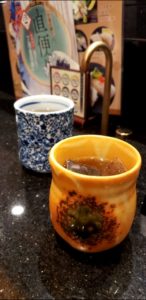 Before going to the table you must remove your shoes and store them in the cabinet. At the table you are given a tea cup and you can make your own tea with the handy hot water spout and selection of tea bags. There is a tablet that is used to order food and there is an English menu for all you non-Japanese speaking foodies.
Before going to the table you must remove your shoes and store them in the cabinet. At the table you are given a tea cup and you can make your own tea with the handy hot water spout and selection of tea bags. There is a tablet that is used to order food and there is an English menu for all you non-Japanese speaking foodies.
Osaka has much more to offer than these 3 restaurants, but there will be no disappointment if you do give ‘em a try. They are all vastly different but each holds a special place in my heart. Always remember that food tastes best when its shared among people and its worth to try everything at least once.
All you need in this world is love and sometimes that comes in the form of food! Happy eating!
Photo Credits:
Top Image: Type specimen licensed under the Creative Commons Attribution-Share Alike 3.0 Unported license. Wikimedia Commons Link
Additional photos were provided by Natalia Lalgee, used with permission.
All other content (text) created by the original author and © 2021 MUSUBI by Borderlink
Top photo: Sheena Honjo (original author), used with permission
Many people are looking for something interesting that they can do when they live in the countryside. I grew up in a city where I saw lot of constant change- buildings here and there, establishments being renovated every now and then, and so on. As I started having my own family, I wanted my kids to enjoy the beauty of nature and experience culture rather than the sounds of traffic and urban chaos. That’s when I realized that living in a countryside was the best option.
In Japan, there are many lesser-known places that tourists seem to miss during their visit. Konan City in Shiga Prefecture is one such place, and it has many things to offer. Here are just a small sampling!
Zensuiji Temple
If you’re a fan of temples, you can visit the Zensuiji Temple, a national treasure, and one of the three Konan Sanzan temples. Zensuiji means “Efficacious Water”. The temple is named after its pond waters, said to have healed Emperor Kanmu’s illness in the 9th century.
It is a popular spot in the fall, when wonderful crimson leaves can be seen, creating a spectacular sight. The interior also features no less than 15 Buddha statues, including representative pieces from the Tempyo period (710 – 794) and the Heian period (794 – 1185), all of which are more than worth making the trip to see them.
Yahei Hot Chili Peppers
These cute finger-like peppers are absolute bombs. I personally love spicy foods, and I’d say that these are among the spiciest I’ve had. It is said that a person named Yahei from Shimoda, Konan City, Shiga Prefecture brought them back from Korea about 100 years ago.
This ‘red’ pepper is actually orange, and its spiciness is twice that of the infamous “hawk’s claws.” With its rich aroma and slight sweetness, it’s a must-try!
Fudo-Taki
Fudo-taki is an about 5-meter-high waterfall radiating a mystic atmosphere. It is formally known as Gyoba Fudo no Taki and Mikumo Dainichi Taisei Fudo Myoo. The waterfall is on the way from Mikumo to Shigaraki, and there is a signboard saying, “Gyoja Fudo no Taki.” An image of Fudo Myoo is inscribed on the rock near the waterfall. It is a great place in summer to enjoy the cold water and just exploring the beauty of nature.
There is so much stunning natural beauty, rich history and beautiful culture to be found in the countryside. And it’s definitely rewarding to find these kinds of hidden gems in Konan City, Shiga! Let’s explore more!
Ready to explore Konan and other cities in Shiga? Now you can as an Assistant Language Teacher! For more information, read all about the job of an ALT!
Photo Credits:
Top photo: Sheena Honjo (original author), used with permission
All other content (text) created by the original author and © 2021 MUSUBI by Borderlink
